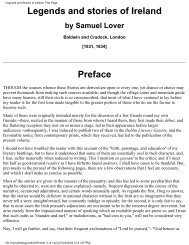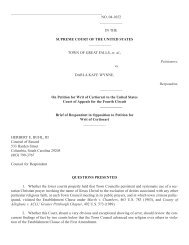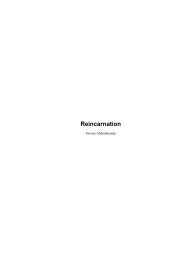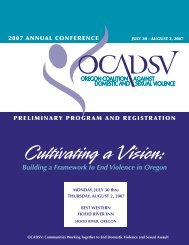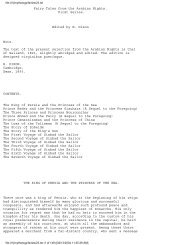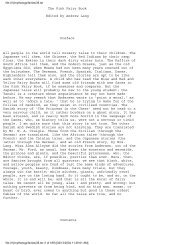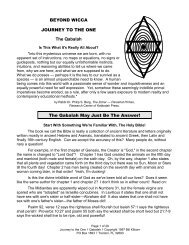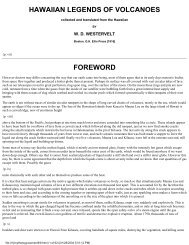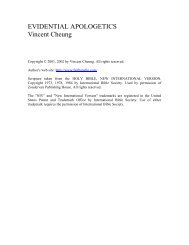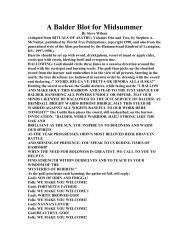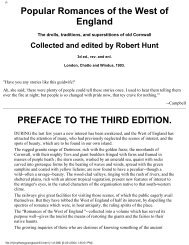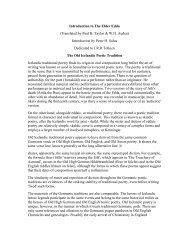Tales and Traditions of the Eskimo - Alternative Religions ...
Tales and Traditions of the Eskimo - Alternative Religions ...
Tales and Traditions of the Eskimo - Alternative Religions ...
You also want an ePaper? Increase the reach of your titles
YUMPU automatically turns print PDFs into web optimized ePapers that Google loves.
<strong>Tales</strong> <strong>and</strong> <strong>Traditions</strong> <strong>of</strong> <strong>the</strong> <strong>Eskimo</strong> - Title Page<br />
have had no intercourse whatever since <strong>the</strong>se regions have been known to Europeans.<br />
3. The Nor<strong>the</strong>rnmost Greenl<strong>and</strong>ers, or inhabitants <strong>of</strong> <strong>the</strong> west coast to <strong>the</strong> north <strong>of</strong> Melville Bay, or what<br />
Sir John Ross called <strong>the</strong> "Arctic Highl<strong>and</strong>ers."<br />
4. The Labrador <strong>Eskimo</strong>.<br />
5. The <strong>Eskimo</strong> <strong>of</strong> <strong>the</strong> middle regions, occupying all <strong>the</strong> coasts from Baffin <strong>and</strong> Hudson Bays to Barter<br />
Isl<strong>and</strong> near Mackenzie River. This division is <strong>the</strong> most widely spread <strong>of</strong> <strong>the</strong>m allits territories<br />
representing an extent <strong>of</strong> l<strong>and</strong>, traversed <strong>and</strong> intercepted in many directions by <strong>the</strong> sea, measuring 2000<br />
miles in length <strong>and</strong> 800 miles in breadth. Perhaps <strong>the</strong>re may be reasons for establishing subdivisions <strong>of</strong><br />
this section, but <strong>the</strong>y do not appear anywhere to exhibit such mutual differences as those separating <strong>the</strong>m<br />
from <strong>the</strong> next tribe, with whom <strong>the</strong>y have regular meetings on Barter Isl<strong>and</strong>.<br />
6. The Western <strong>Eskimo</strong>, inhabiting <strong>the</strong> remaining p. 4 coast <strong>of</strong> America from Barter Isl<strong>and</strong> to <strong>the</strong> west <strong>and</strong><br />
south. They seem to deviate from all <strong>the</strong> former in respect <strong>of</strong> certain habits, such as <strong>the</strong> labial ornaments<br />
<strong>of</strong> <strong>the</strong> men <strong>and</strong> <strong>the</strong> head-dress <strong>of</strong> <strong>the</strong> women. They must also be considered as <strong>the</strong> nearest akin to <strong>the</strong><br />
Aleutians <strong>and</strong> <strong>the</strong> inl<strong>and</strong> <strong>Eskimo</strong>, <strong>and</strong> in <strong>the</strong> vicinity <strong>of</strong> Alaska <strong>the</strong>y show traces <strong>of</strong> intermingled Indian<br />
blood. This may be owing to <strong>the</strong> Indian women captured in war with <strong>the</strong> <strong>Eskimo</strong> having been married<br />
into <strong>the</strong> nation.<br />
7. The Asiatic <strong>Eskimo</strong>.<br />
As regards <strong>the</strong>ir development when <strong>the</strong>y first became known to modern Europeans, <strong>the</strong> <strong>Eskimo</strong> may be<br />
classed with <strong>the</strong> prehistoric races <strong>of</strong> <strong>the</strong> age <strong>of</strong> <strong>the</strong> ground stone tools with <strong>the</strong> exceptional use <strong>of</strong> metals.<br />
It has been usual to designate all nations <strong>of</strong> this kind as "savages;" some authors have even described<br />
<strong>the</strong>m as being totally destitute <strong>of</strong> those mental qualities through which any kind <strong>of</strong> culture is manifested,<br />
such as social order, laws, sciences, arts, <strong>and</strong> even religion. That those opinions find utterance can<br />
scarcely be wondered at when we observe <strong>the</strong> carelessness with which such important questions are<br />
discussed, <strong>and</strong> see travellers who merely go on shore from a ship <strong>and</strong> spend a couple <strong>of</strong> hours with <strong>the</strong><br />
inhabitants proceed to make inquiries as to <strong>the</strong>ir ideas <strong>of</strong> God <strong>and</strong> <strong>the</strong> origin <strong>of</strong> <strong>the</strong> world; <strong>and</strong> also how<br />
European settlers among natives whose language <strong>the</strong>y are quite unconversant with pretend to have found<br />
<strong>the</strong>m altoge<strong>the</strong>r without religion. Such views, however, resting upon <strong>the</strong> prejudice <strong>of</strong> race <strong>and</strong> on<br />
superficial observation, are now being ab<strong>and</strong>oned. We have gradually been finding out that<br />
manifestations <strong>of</strong> culture must be supposed to exist in every nation, although <strong>the</strong>y may not assume <strong>the</strong><br />
same form as those we observe among more advanced races. We think it a great mistake to suppose any<br />
people devoid <strong>of</strong> religion; <strong>and</strong> it seems to us equally unreasonable p. 5 to fancy a community <strong>of</strong> men<br />
living altoge<strong>the</strong>r without laws, if by laws we underst<strong>and</strong> bonds or restrictions by which <strong>the</strong> community<br />
voluntarily limits <strong>the</strong> free actions <strong>of</strong> its members. In <strong>the</strong> lower stages <strong>of</strong> development, <strong>the</strong> laws, being<br />
principally represented by habits <strong>and</strong> customs, leave <strong>the</strong> individual perhaps even less free than in a more<br />
civilised state, inasmuch as <strong>the</strong>y dictate his mode <strong>of</strong> life, <strong>and</strong> not even in his most private <strong>and</strong> domestic<br />
affairs is he left to act at liberty. These habits <strong>and</strong> customs are closely allied to <strong>the</strong> religious opinions, by<br />
which <strong>the</strong>y are still more powerfully influenced. When laws <strong>and</strong> religion were asserted to be wanting,<br />
<strong>the</strong>re was still less likelihood <strong>of</strong> art <strong>and</strong> science being observed. In <strong>the</strong> following introduction we shall<br />
endeavour to explain how <strong>the</strong>se utterances <strong>of</strong> culture are for <strong>the</strong> most part embodied in <strong>the</strong> traditional<br />
tales.<br />
It is in accordance with <strong>the</strong> views here stated that <strong>the</strong> author has been guided in attempting to divide <strong>and</strong><br />
file:///I|/mythology/american indian/24/24.html (10 <strong>of</strong> 317) [01/24/2004 8:57:48 AM]



